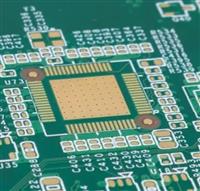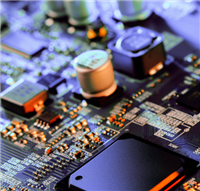
PWB
Printed Wiring Board; same as PCB.
Pull Strength
See Bond Strength.
PTH
Plated through-holes. Plating the holes on their internal wall.
Production Master
A 1 to 1 (1:1) scale pattern which is used to produce one or more printed boards (rigid or flexible) within the accuracy specified on the master drawing.
Process Indicator
A detectable anomaly, other than a defect, that is reflective of material, equipment, process and/or workmanship variations.
Probing Systems
Equipment for making electrical contact between the bare PCB, components or assemblies and the continuity tester. Probling devices range from manual units for low volumes to computer-controlled systems.
Printed Wiring
A conductive pattern within or bonded to the surface of a base material intended for point-to-point connection of separate components and not containing printed components.
Printed Wiring Layout
A sketch that depicts the printed wiring substrate, the physical size and location of electronic and mechanical components, and the routing of conductors that electrically interconnect components, in sufficient details to allow the preparation of documentation and artwork.
Printed Wiring Board
See Printed Board.
Printed Wiring Assembly Drawing
A document that shows the printed board (rigid or flexible), the separately manufactured components which are to be added to the board, and any other information necessary to describe the joining of these parts to perform a specific function
Printed Contact
A portion of conductive pattern formed by printing, serving as one part of a contact system.
Printed Component
A component part, such as an inductor, resistor, capacitor, or transmission line, which is formed as part of the conductive pattern of the printed board.
Printed Circuit
Circuit where the interconnections between components, terminals, sub-insulating board
Printed Circuit Assembly
A printed circuit board to which discrete components; hardware, and other electronic devices have been attached to form a complete operating unit.
Printed Board
The general term for completely processed printed circuit or printed wiring configuration. It includes signle, double, and multi-layer boards, both rigid and flexible.
Printed Board Assembly
A printed board with electrical or mechanical components, other printed boards, or a combination of there, attached to it with all manufacturing processes, soldering, coating, etc. Completed.
Primer
A coating applied before the application of an adhesive to improve the bond.
Press-fit Contact
An electrical pin contact which can be pressed into a hold in a printed board to make immediate contact.
Prepreg
Sheet material consisting of the base material impregnated with a synthetic resin, such as epoxy or polymide, partially cured to the B-stage.
Pre-heat
The process portion of the re-flow heat curve in which the PCB is heated from ambient at a pre-set rate and prior to full liquidus at the solder joint areas.
Positive-acting Resist
A resist which is decomposed (softened) by light and which, after exposure and development, is removed from those areas which were under the transparent parts of a production master.
Positive (noun)
An artwork, artwork master, or production master in which the intended conductive pattern is opaque to light, and the areas intended to be free from conductive material are transparent.
Populated PCB
A printed board on to which all passive and active components have been assembled. Synonyms: printed board assembly (PBA), card, assembled board.
Polyimide
(kapton) Higher melting point plastic film used as base for flexible portions of flexi-rigid boards as well as for many flexible circuits.
Polyimide Resins
High temperature thermoplastics used with glass to produce printed circuit laminates from multi-layer and other circuit applications requiring high temperature performance.
Polyester
(mylar) low melting point plastic film used for cheap flexible circuits.
Polarization
A technique of eliminating symmetry within a plane so that parts can be engaged in only one way in order to minimize the possibility of electrical and mechanical damage or malfunction.
Poise
A centimeter-gram-second unit of viscosity equal to that of a fluid requiring a shearing force of one dyne to move from a square centimeter area which a velocity of one centimeter per second (cps).
Plotting
The practice of mechanically converting X - Y position information into a visual pattern, such as artwork.
Plating
A uniform coating of conductive metal upon the base material of the printed circuit board.
Plating Up
The process consisting of the electrochemical deposition of a conductive material on the base material (surface holes, etc.) after the base material has been made conductive.
Plating Resists
Materials which, when deposited on conductive areas, prevent the plating of the covered areas. Resists are available both as screened-on materials and as dry-film photopolymer resists.
Plating Bar
The temporary conductive path interconnecting areas of a printed board to be electroplated, usually located on the panel outside the borders of such a board.
Plated Through-hole
A hole with the deposition of metal (usually copper) on its sides to provide electrical connections between internal or external conductive patterns.
Plate Finish
Pertaining to Laminating. The finish present on the metallic surface of metal clad base material resulting from direct contact with the laminating press plates without modification by any subsequent finishing process.
Pitting
Small holes or sharp edges on the surface of a solder joint generally caused by flux entrapment, oxidation or over-heating.
Pit
A depression in the conductive layer that does not penetrate entirely through it.
Pink Ring
Chemically-induced fracturing or de-lamination on or below the surface of the base material; it is usually exhibited by a light area around holes, other etched areas or both.
Pinholes
Small imperfection which penetrate entirely through the conductor and/or solder.
Pinhole
A minute hole through a layer of pattern.
Pin
A terminal on a component. A component lead that is not readily formable without being damaged.
Pin Density
The quantity of pins on a printed board per unit area.
Pilot Hole
See Locating Hole.
PIH Assembly
Pin-in-hole a printed board assembly made up of components with leads which pass through holes in the board and lands. Synonyms: traditional assembly, conventional assembly.
Pick-and-place Machine
A programmable machine usually with a robot arm for picking components from a feeder. It moves the part for placement and/or insertion to a specific site on the board.
Physical Layer
A conductive board layer or artwork image representing a complete conductive layer.
Photoplotter
A plotter that writes using light.
Photopolymer
A polymer that changes characteristics when exposed to light of a specific frequency.
Photomaster
See Artwork Master.
Permanent Mask
A resist which is not removed after processing, e.g., plating resist used in the fully-additive process.
Peel Strength
The force per unit width required to peel the conductor or foil from the base material.
PEC
Printed Electronic Component.
PCB
Printed Circuit Board.
Pattern
The configuration of all conductive and/or non-conductive areas on a PCB. Letters and inscription may also be included. Pattern also denotes the circuit configuration on related tools, drawing and masters. Synonym: image
Pattern Plating
Selective plating of a conducive pattern.
Parylene
A polymer resin (Polyparaxylense) that provides a thin, uniform coating on PCBs and components. It can be applied via vacuum for deposition on sharp edges and complex shapes.
Panel Plating
The plating of the entire surface of a panel (including holes).
Panel
The base material containing one or more circuit patterns that passes successively through the production sequence and from which printed circuit boards are extracted. See Backplanes/Backpanels.
Pad
A portion of the conductive area of which components, terminals, traces, etc., are mechanically attached. (Also called land).
Packaging Density
Quantity of functions (components, interconnection devices, mechanical devices) per unit volume, usually expressed in qualitative terms, such as high, medium, or low.





